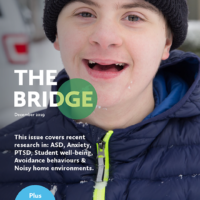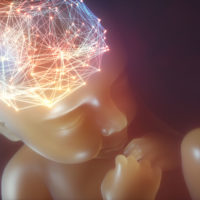Children and adolescents who are experiencing difficulties with their mental health also often struggle with their sleep. Indeed disrupted or altered sleep has been associated with most psychiatric disorders (Gregory & Sadeh, 2016). Although a range of sleep difficulties can co-occur with mental health problems, a common difficulty is insomnia. As such this guidance will primarily focus on difficulties with getting to sleep and staying asleep.
Sleep
-

December 2019 issue – The Bridge
Summaries include; if parental consanguinity predicts the severity of Autistic symptoms; study the transmission of intergenerational anxiety in families; systematic review into the effectiveness of available interventions to treat PTSD; the efficacy of teacher assessments vs exams to assess performance in UK schools; relationship between intolerance of uncertainty and extreme demand avoidance in young people with Autism; and how fluctuations in external environmental noise affect the developing Autonomic Nervous System in babies.
Read more -

JCPP and CAMH editorial team members listed among most highly cited researchers in the world
Who made the most cited list?
Read more -

December 2019 The Bridge Editorial
It has been 2 years since The Bridge was relaunched in its current form. Each monthly themed edition publishes summaries of selected papers from the ACAMH journals – JCPP and CAMH – and occasionally features guest research digests. Over the past two years we have covered a huge range of topics and published over 170 research summaries and counting.
Read more -

2019 Judy Dunn National Conference ‘Suicide and self-harm in young people’ – Prof. Christian Schmahl
The 2019 Judy Dunn Conference focused on ‘Suicide and self-harm in young people’. Prof. Christian Schmahl on the ‘Neurobiology of self-harm in BPD’. ACAMH members can now receive a CPD certificate for watching this recorded lecture. Simply email membership@acamh.org with the day and time you watch it, so we can check the analytics, and we’ll email you your certificate.
Read more -

Prof. Paramala J Santosh ‘Mobile applications and wearable devices in assessing suicide risk’
ACAMH members can now receive a CPD certificate for watching this recorded lecture. Simply email membership@acamh.org with the day and time you watch it, so we can check the analytics, and we’ll email you your certificate.
Read more -

Sleep Disorders in Children and Young People
Problems sleeping is a common symptom of many mental health difficulties in young people, such as anxiety, depression, and behavioural difficulties. In some instances, sleep has been found to be amongst the most common symptoms reported in young people with mental health problems.
Read more -

Good intentions, good enough?
Daniel Brennan, Assistant Psychologist at Ealing Intensive Therapeutic and Short Break Service (ITSBS) provides a summary of Lenehan, C. and Geraghty, M. (2017) “Good intentions, good enough?: a review of the experiences and outcomes of children and young people with learning disabilities in residential special schools and colleges”,
Read more -

Just what does a learning disability nurse do?
”As a clinical nurse specialist, and manager, there is no typical day.”- Julie Blackaby. “It is probably the liveliest and most exciting it has been since the advent of the NHS”- Noeleen Morritt.
Read more -

-

Identifying imaging biomarkers in the neonatal brain
The past decade has seen great improvements in magnetic resonance imaging technologies, such that it is now possible to image the developing brain in utero. In 2018, Dafnis Batalle and colleagues compiled an Annual Research Review for the Journal of Child Psychology and Psychiatry, where they evaluated the current status of neuroimaging research in neonates and paediatrics to determine the origins of neuropsychiatric and neurodevelopmental disorders.
Read more